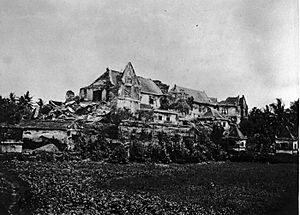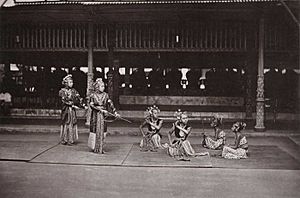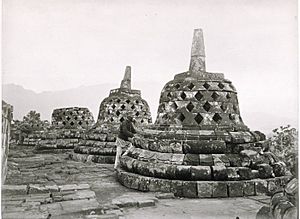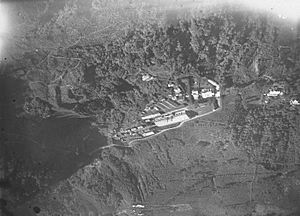Kassian Cephas facts for kids
Quick facts for kids
Kassian Cephas
|
|
|---|---|
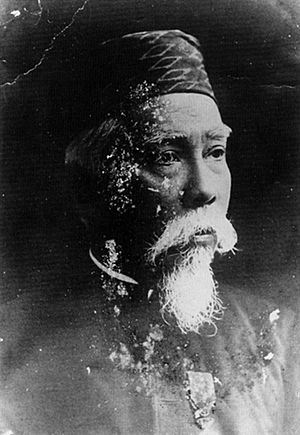
Kassian Cephas wearing the honorary gold medal of the Order of Orange-Nassau (c. 1905)
|
|
| Born |
Kassian
15 January 1845 Yogyakarta Sultanate
|
| Died | 16 November 1912 (aged 67) Yogyakarta Sultanate
|
| Known for | Photography |
Kassian Cephas (born January 15, 1845 – died November 16, 1912) was a famous Javanese photographer. He worked for the royal family of the Yogyakarta Sultanate in Java, Indonesia. He was the first person from Indonesia to become a professional photographer.
Sultan Hamengkubuwana VI (who ruled from 1855 to 1877) asked for Cephas to be trained. By 1871, he became the official court photographer. He took many portraits of the royal family. He also took pictures for a Dutch group that studied old buildings. Cephas helped save Java's history through his photos. He was even given a special gold medal for his work. Kassian Cephas and his wife, Dina Rakijah, had four children. Their oldest son, Sem Cephas, continued the family's photography business.
Contents
Early life
Kassian Cephas was born in Yogyakarta, a city in Java. His parents were Kartodrono and Minah. When he was young, Cephas became a student of Christina Petronella Philips-Steven. She was a Christian missionary. He moved with her to a nearby town called Bagelen.
On December 27, 1860, when he was fifteen, he was baptized there. He chose the name Cephas, which means "Peter" in the Aramaic language. After this, he started using Cephas as his family name.
Photography career
When Cephas returned to Yogyakarta in the early 1860s, he started learning photography. His teacher was Simon Willem Camerik, who was also a photographer for the Sultan's court. Sultan Hamengkubuwana VI noticed Cephas's talent and asked for him to be trained. By 1871, Cephas was officially named the court painter and photographer.
Cephas's photography studio was on the second floor of his home in Yogyakarta. Besides taking portraits of people, Cephas also photographed many buildings and old monuments. For example, he took pictures of the Taman Sari Water Castle in 1884 for a respected Dutch society.
Professional works
Cephas's photos first became widely known in 1888. They were in a book called In den Kedaton te Jogjåkartå by Isaäc Groneman. This book had 16 special photo prints of Hindu Javanese dances. Groneman wanted people in the Netherlands to learn about this culture. He asked Sultan Hamengkubuwana VII for permission for Cephas to photograph the dance scenes.
A Dutch institute first planned to publish the book. But it was too expensive to make the special photo prints. In 1886, Cephas bought a new camera. This camera could take pictures very quickly, in 1/400th of a second. This meant people didn't have to stay still for a long time. These photos were often given as gifts to important European visitors leaving Yogyakarta.
In 1889, a group called the Archaeological Union started to study and protect old Hindu Javanese buildings in Central Java. The Prambanan temple was one of their main projects. Cephas was asked to photograph the site. His oldest son, Sem, drew the plans of the buildings. Groneman sent Cephas's photos and notes to the Royal Institute in 1891. But it took until 1893 for them to be published because of the high printing costs. The final book included 62 photo prints of Prambanan and nearby temples.
Cephas also photographed the famous Borobudur temple complex. Its hidden base was found in 1885. The base was uncovered briefly in 1890 to be photographed. Then it was covered again in 1891. Cephas did not get enough money from the government to take all the photos needed. He had planned to take 300 photos. Developing each photo plate took about half an hour. In the end, he took 160 photos of the base's reliefs (carvings). He also took four general overview photos of the site. These photos were published 30 years later in a collection by the Royal Institute.
International recognition
After finishing the Borobudur project, Cephas was made a "special member" of the Batavian Society of Arts and Sciences. This was for his work as a photographer and for studying old buildings in the Indies. A few years later, he was asked to join the Royal Institute because of his work with the Archaeological Union. Cephas accepted this honor in 1896. Later that year, he photographed a visit by King Chulalongkorn of Thailand to Yogyakarta. The king gave him a special gift of three jeweled buttons.
Groneman and Cephas worked together one last time in 1899. They documented a big event celebrating Hamengkunegara III becoming Crown Prince of the Yogyakarta Sultanate. This event took a year and a half to prepare. A huge show lasted four days, with thousands of people watching each day. A special book about the show, covered in blue velvet, gold, and diamonds, was given as a wedding gift to Queen Wilhelmina and Prince Henry of the Netherlands in 1901. Later that year, on Queen Wilhelmina's 21st birthday, Cephas received an honorary gold medal of the Order of Orange-Nassau. This award was for his important work in showing and saving Java's cultural history.
Death and legacy
Cephas stopped working as a photographer when he was about 60 years old. His wife passed away in September 1911. Just over a year later, Cephas died at age 67 due to illness. The family's photography business ended a few years later when his son, Sem Cephas, died in a horseriding accident in 1918.
Kassian Cephas, his wife, and his son were all buried in Yogyakarta. Their graves were later moved in 1964 to make way for new buildings. Both Cephas and his son were skilled court photographers. However, Kassian Cephas was the most important. He was the first Javanese person, and the first person from Indonesia, to become a professional photographer.
Personal life
Cephas married Dina Rakijah (born 1846) on January 22, 1866. She was a Christian Javanese woman. They had one daughter and three sons: Naomi (born 1866), Sem (born 1870), Fares (born 1872), and Jozef (born 1881). They also had a son named Jacob who was born in 1868 but died the same year. Naomi married a Dutch engineer, Christiaan Beem, in 1882. They had thirteen children, and eight of them grew up to be adults. Cephas's oldest son, Sem, became a photographer and painter in his father's studio.
Gallery
See also
- Isidore van Kinsbergen
- History of photography
- Tassilo Adam, court photographer for the VII Sultan


